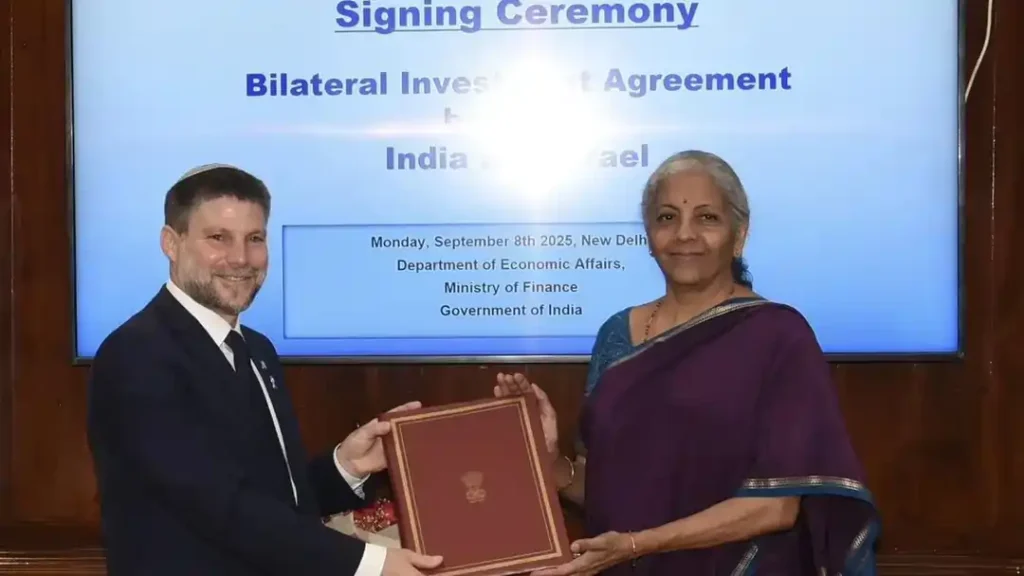New Delhi: In a groundbreaking move poised to redefine economic ties between two dynamic democracies, Israel has become the first Organisation for Economic Co-operation and Development (OECD) member to sign a Bilateral Investment Treaty (BIT) with India. Signed on September 8, 2025, in New Delhi, this landmark agreement marks a significant milestone in fostering mutual investment and trade, replacing a previous treaty from 1996 that ended in 2017. The pact, aligned with India’s modernized 2015 Model BIT, is set to unlock new opportunities for businesses, bolster investor confidence, and strengthen strategic cooperation amid a complex global landscape.

A Strategic Signing Ceremony in New Delhi
The agreement was formalized by Israel’s Finance Minister Bezalel Smotrich and India’s Minister of Corporate Affairs and Finance, Nirmala Sitharaman, during a high-profile visit by an Israeli delegation to India’s capital. Smotrich, a key figure in Israel’s far-right Religious Zionist Party, was accompanied by senior officials, including Director General Ilan Rom, Chief Economist Dr. Shmuel Abramzon, Accountant General Yahli Rothenberg, and Chairman of the Israel Securities Authority, Seffy Zinger. The delegation’s presence underscored the multifaceted discussions, which extended beyond the BIT to explore collaborations in innovation, infrastructure, financial regulation, and digital services.
Sitharaman highlighted the treaty’s potential to deepen partnerships in critical sectors such as cybersecurity, defense, and high-technology. “This agreement will pave the way for greater collaboration, driving innovation and economic growth,” she stated. Smotrich echoed her optimism, calling the deal “an important strategic step for our joint vision” that will “open new opportunities for investors, strengthen Israeli exports, and provide businesses with tools to thrive in one of the world’s fastest-growing markets.” He also extended an invitation to Sitharaman for a reciprocal visit to Israel, signaling a commitment to sustained dialogue.
India’s Ministry of Finance described the agreement as a “historic milestone,” emphasizing its role in advancing fintech innovation, infrastructure development, financial regulation, and digital payment connectivity. Both nations agreed to explore establishing a bilateral financial protocol to streamline cross-border financial operations, further solidifying their economic alliance.
Reviving a Legacy: The Evolution of India-Israel BIT
The 2025 BIT replaces a 1996 agreement terminated in 2017 as part of India’s strategic overhaul of its investment treaties. In 2015, India introduced a new Model BIT, replacing the 1993 framework, to balance investor protections with the state’s regulatory rights. This modernized approach has led to recent BITs with Uzbekistan (2024), the United Arab Emirates (2024), and Kyrgyzstan (2025). Israel’s inclusion as the first OECD nation to adopt this framework underscores India’s growing appeal as a destination for advanced economies’ investments.
Under international law, BITs are recognized as primary sources of obligations per Article 38(1)(a) of the Statute of the International Court of Justice. These reciprocal agreements between sovereign states promote and protect investments by nationals in each other’s territories. The Israel-India BIT 2025 is designed to provide a stable, predictable environment for investors, fostering confidence in cross-border ventures.
Key Features of the Israel-India BIT
The treaty introduces several critical provisions to catalyze economic growth:
- Boost to Investment: With current bilateral investments at USD 800 million, the BIT aims to significantly increase capital flows by creating a secure investment climate. It positions both nations to leverage their respective strengths—Israel’s technological prowess and India’s vast market potential.
- Investor Protection: The agreement ensures a minimum standard of treatment for investors, balancing protections with the state’s right to regulate in the public interest, such as environmental or labor policies. This equilibrium addresses concerns from earlier BITs that favored corporate interests excessively.
- Dispute Resolution: A robust arbitration mechanism facilitates efficient resolution of investment disputes, reducing risks for businesses and encouraging trade expansion. This provision is crucial for Indian firms eyeing Israel’s innovation ecosystem and Israeli companies targeting India’s consumer base.
These features are expected to drive foreign direct investment (FDI) in sectors like technology, manufacturing, and services, setting a precedent for future OECD-India agreements.
A Multifaceted Partnership: Beyond the BIT
The BIT is a cornerstone of a broader, evolving relationship between India and Israel, spanning economic, defense, and cultural domains. In fiscal year 2023-24, bilateral trade reached USD 6.53 billion (excluding defense), with India maintaining an export surplus. In 2024, trade was recorded at USD 3.9 billion, with defense and security forming a significant portion—India is Israel’s largest weapons buyer. An Al Jazeera investigation revealed that Indian firms supplied rockets and explosives to Israel during its 2023-2025 Gaza conflict, highlighting the strategic depth of their defense ties.
Regionally, the I2U2 Partnership, involving India, Israel, the UAE, and the United States, launched its first summit in 2022, focusing on clean energy, food security, and water technologies. This quadrilateral platform exemplifies how both nations leverage multilateral frameworks for mutual benefit.
In innovation, the India-Israel Industrial R&D and Innovation Fund (I4F), active from 2023 to 2027, supports joint research in artificial intelligence, biotechnology, and renewable energy. Defense cooperation includes co-developed systems like the Barak-8 missile defense platform and regular Israeli naval port calls in Haifa, reflecting operational synergy.
Cultural exchanges thrive through dedicated programs, while cooperation in health, medicine, agriculture, and water resource management addresses shared challenges. Indians constitute the largest group of foreign students in Israel, fostering academic ties, while Israeli construction firms seek to hire up to 100,000 Indian workers to replace Palestinian laborers whose permits were revoked post-October 2023.
Geopolitical Context: Navigating Complexities
The BIT’s signing occurs against the backdrop of Israel’s ongoing military operations in Gaza, which have killed over 64,000 Palestinians since October 2023, sparking global outrage. Smotrich, sanctioned by several Western nations for his ties to illegal West Bank settlements, has drawn criticism for inflammatory statements, including a May 2025 remark predicting Gaza’s demographic reduction and a recent proposal to annex 82 percent of the West Bank. These controversies underscore the geopolitical sensitivities surrounding the agreement.
India’s stance adds complexity. While officially supporting a two-state solution for the Israel-Palestine conflict, New Delhi has abstained from UN resolutions critical of Israel, including a 2024 General Assembly vote for an immediate Gaza ceasefire. Indian authorities have restricted pro-Palestine protests, sometimes criminalizing them, while allowing pro-Israel rallies. Following U.S. President Donald Trump’s 50 percent tariffs on India in 2025, New Delhi endorsed a Shanghai Cooperation Organisation (SCO) statement condemning U.S.-Israeli strikes on Iran, reflecting a delicate balancing act. Meanwhile, efforts to mend ties with China, with President Xi Jinping advocating partnership over rivalry, indicate India’s strategic recalibration.
Future Prospects: A Catalyst for Growth
The Israel-India BIT 2025 is poised to transform bilateral economic ties, with projections suggesting doubled trade and investment within a decade. By fostering cooperation in fintech, infrastructure, and digital economies, the treaty aligns with both nations’ aspirations for innovation-driven growth. Its arbitration mechanisms and balanced protections provide a resilient foundation for businesses navigating global uncertainties.
Challenges remain, including domestic concerns in India over arms trade and geopolitical frictions. However, the commitment to reciprocal visits and financial protocols signals a long-term vision. As the first OECD-India BIT, this agreement could inspire similar pacts, enhancing India’s global investment profile.
Conclusion: A Vision for Prosperity
The Israel-India Bilateral Investment Agreement of 2025 transcends economic metrics, embodying a strategic partnership rooted in shared goals. For investors, it opens doors to innovation and growth; for policymakers, it charts a path to mutual prosperity. As both nations navigate a turbulent global stage, this historic pact stands as a testament to their resilience and ambition, promising a brighter, interconnected future.
Frequently Asked Questions
1. What is the Israel-India Bilateral Investment Treaty (BIT) signed in 2025?
The Israel-India Bilateral Investment Treaty (BIT), signed on September 8, 2025, in New Delhi, is a reciprocal legal agreement between Israel and India aimed at promoting and protecting investments by nationals and companies in each other’s territories. As the first such treaty between India and an OECD member state, it replaces a 1996 BIT terminated in 2017 and aligns with India’s 2015 Model BIT. The agreement facilitates increased bilateral investments (currently USD 800 million), ensures investor protections while preserving state regulatory rights, and includes arbitration mechanisms for dispute resolution.
2. How does the 2025 BIT benefit India and Israel economically?
The BIT is designed to boost bilateral trade and investment by creating a stable and predictable environment for investors. It aims to significantly increase the current USD 800 million in mutual investments, fostering growth in sectors like fintech, infrastructure, cybersecurity, and high-technology. With bilateral trade at USD 6.53 billion in FY 2023-24 (excluding defense) and USD 3.9 billion in 2024, the treaty enhances opportunities for Indian firms in Israel’s innovation ecosystem and Israeli businesses in India’s vast market, potentially doubling trade volumes within a decade.
3. What are the key features of the Israel-India BIT 2025?
The treaty includes three core components:
Dispute Resolution: Incorporates arbitration mechanisms to resolve investment disputes efficiently, reducing risks for businesses and supporting trade expansion.
Investment Boost: Encourages higher capital flows by providing a secure investment climate.
Investor Protection: Balances investor rights with the state’s regulatory authority, ensuring fair treatment and safeguards against arbitrary actions.
4. How does the BIT fit into the broader India-Israel relationship?
The BIT is part of a multifaceted partnership spanning economic, defense, and cultural domains. Beyond trade (USD 6.53 billion in FY 2023-24), the nations collaborate through the I2U2 Partnership (with UAE and US), the India-Israel Industrial R&D and Innovation Fund (2023-2027), and co-developed defense systems like the Barak-8 missile. Cultural exchanges, health, agriculture, and water management initiatives, along with Indians forming the largest foreign student group in Israel, further strengthen ties. The BIT enhances these synergies by fostering economic collaboration in innovation, infrastructure, and digital services.
5. Why is the timing of the BIT signing significant, and what controversies surround it?
Signed amid Israel’s ongoing military operations in Gaza, which have resulted in over 64,000 Palestinian deaths since October 2023, the BIT has sparked debate due to global criticism of Israel’s actions. Israel’s Finance Minister Bezalel Smotrich, a far-right figure sanctioned by Western nations for ties to West Bank settlements, has made controversial statements, including proposals to annex 82% of the West Bank. India’s abstention from UN resolutions critical of Israel and restrictions on pro-Palestine protests add complexity. Despite these tensions, the BIT underscores India’s strategic alignment with Israel, navigating geopolitical challenges while pursuing economic growth.

